In my woodworking workshop, I have several large machines that generate dust. I have a Table Saw, a Radial Arm Saw, A large Bandsaw, a small Bandsaw, a 12” Planer, and a Router table. There is a King scrollsaw that my partner uses and I do a considerable amount of sanding and planing as well as generate dust from Circular Saws, a Drill Press, and my Lathe. I am in need of a small woodshop dust collection system that will get a handle on all of this dust created by my woodworking activities.
How Does a Dust Collection System Work?
A dust collection system generates a high-velocity stream of air to draw the dust and small particles into a hose. The hose deposits this dust into a chamber where the dust is removed from the air.
Many Woodshops will have a central dust collection system that is connected to the large machines by dust collection conduit. Other Woodshops will have dedicated dust collection machines for each tool. Some small Woodshops will have a system that is portable and can be moved to the location that is generating the dust where it is being created.
I have implemented a combination of these solutions. A three-pronged approach is the best solution. I have a small single-stage dust collector near the scroll saw and drum sander, and a portable 2 stage dust collector for the larger tools. A shop vac with pre-separator services the small tools. Overhead a box fan will collect the fine dust through a standard home air filter and then blows out through another electrostatic filter.
How Much Dust Collection Do I Need?
As I mentioned above, I have some large dust-generating machines. Each of these has a specific need to remove the dust it generates.
How Much CFM Do I Need for Dust Collection?
| Machine | CFM Requirements |
| Table Saw 10” | 300-400 |
| Band Saw 16” | 350-400 |
| Planer- 12” | 500 |
| Disc sander | 300-350 |
| Belt Sander | 550-600 |
| Drill Press | 300 |
| Scroll Saw | 300-350 |
| Router (Table Mounted) | 200 |
| Band Saw- 4” | 150 |
For my largest machine, I need about 500-600 CFM. I don’t know of a shop vac that will generate this kind of volume (In general, a shop vac generates about 165 CFM)so, I need to have some sort of dust collection system that can generate this volume of air. A small impeller based collection system with a 4” hose and a filter are what I need.
What do the Specifications for Dust Collectors Mean?
There are two main specifications that are used when discussing Dust Collection systems. These are CFM and FPM.
CFM stands for Cubic Feet per minute and is the measurement of how much air can flow through the system. CFM is determined by the velocity of the air and the size of the pipe that it is flowing through.
FPM or Feet per Minute is a measurement of the speed of the airflow.
Higher velocity air has more carrying power for the dust generated at the machines but this typically comes with a smaller hose and less overall volume.
Can a Shop-vac be Used for Dust Collection?
A shop vac can be used for a light-duty dust collection system but only for small particles and small amounts of dust. I do use my shop vac to collect dust from my 4” Bandsaw. I also place a wide end on the hose and keep it near my random orbit sander when I’m using that to gather the fine dust that is generated and keep it away from my lungs(with a dust mask).
For larger machines and most cutting operations, the shop vac doesn’t pull enough volume for adequate dust collection.
What is a 2-Stage Dust Collector?
A 2-stage dust collector is a single-stage impeller and filter with a chip separator on the input side of the dust collector. The chip separator is typically a cyclone separator but may be a Thein baffle. The separator keeps the large chips and coarse dust out of the impeller and lets the fine dust pass through and get caught by the filter bag.
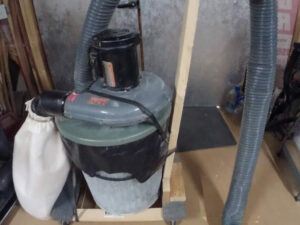
What is the Advantage of a Cyclone Dust Collector?
Removing the larger particles from your dust collection stream does two things. First and foremost, it increases the life of your filter bag and the impeller/fan works less hard and pulls less power to maintain its speed. It also allows more time between bag cleaning or filter replacement. This is often a very dusty operation and puts lots of fine particles back into the air of your shop. The bags and filters are somewhat expensive and any reduction in replacement cost is a good thing.
A much cleaner operation is emptying the coarse dust and chips that are collected by the cyclone. Less fine particulates will be generated to get back into the air in your shop and perhaps get into your lungs.
If you have a cyclone installed before your shop vacuum, you may increase the life of the vacuum itself. The fan in the shop vacuum draws less power through a clean filter.
What is a Thien Baffle Dust Collector?
The Thein baffle system is a plywood sheet that is sized to fit inside the collection bucket, It has a slot cut around 240 degrees of the edge that allows dust to fall below the baffle into the collection area. Incoming air is directed around the outside of the collection bucket. Friction against the outside of the bucket slows down the dust where it falls below the baffle into an area of less air turbulence. This allows the dust to settle.
Thien Baffle systems don’t appear to be available for purchase. You need to put on your DIY hat and fabricate one for yourself. There are lots of YouTube videos and forums that discuss the design and implementation of the Thien Baffle system.
To get you started, here’s a link from the JP Thien website that explains how the baffle goes together.(http://www.jpthien.com/cy.htm).
Clearing the Air in Your Shop
What size is wood dust?
Wood Dust ranges in size from 1 micron to up to 90 microns. Above this size, the wood dust is referred to as chips. Removing the chips does nothing for the smallest particles that can clog your lungs. Most filter bags that come with dust collection systems will filter down to 2-3 microns. Particles smaller than the filter can handle should be removed by an air cleaner that pulls air through a set of filters.
How long does wood dust stay in the air?
A significant amount of wood dust smaller than 10 microns can be suspended in the air for up to 30 minutes by the simple act of sweeping your shop.
Using Saws and sanders can generate a lot of dust. Place dust collection as close to your equipment as possible. Many shops will create a ducting system that pulls the dust to a central collector. The ductwork creates significant losses in the system and makes it necessary to oversize the system. 4” hoses and ductwork should be the minimum size with 6-inch being the optimal size. 6-inch ductwork will require at least a 2 HP motor to pull sufficient volumes of air.
Dust collection and air filtration is a must!
What do I Need to Implement for Dust Collection?
In my shop, I settled on a portable dust collection unit with a 4-inch hose 10 feet long. Each machine has a dust collection port that I can plug the unit into after I have wheeled it over near the machine.
I have added an angled collector under my Table Saw (Contractor Saw) that catches the dust as it falls through the table. I will be adding an enclosure for the back of the saw that surrounds the motor area. This will double as permanent outfeed support as well.
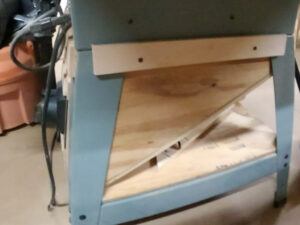
On the Radial Arm Saw, I cut slots in the fence and covered the area behind the fence. A slot in the cover was cut for the saw blade. I am constantly amazed at the efficiency of this small change.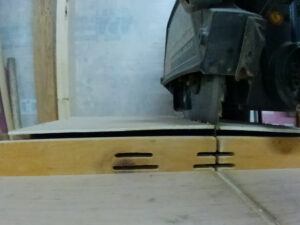
I added a 4” port to the back of the Router Table when I built it. Eventually, I’ll be building a full Router Stand and include under the table dust collection but for now, this works to collect the amount of fine dust that is produced by the Router. It is a bit less effective at the larger dust but will collect at least 80% of the larger chips as well.
The Band Saw has a dual-port system. I connected the two ports with a Y connector and some short hose. This then has a port for the 4” dust collector hose. I’m not especially thrilled about the effectiveness of this arrangement. Lots of coarse dust remains around the Bandsaw when I’m done using it.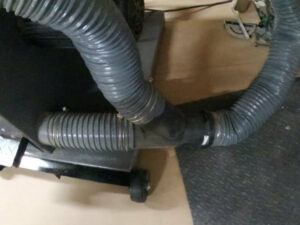
The only remaining thing that I need to build is a box that contains a 20-inch box fan with recesses that can have filters quickly installed and replaced. This will cycle the air in the shop several times an hour and pull the fine particles that are suspended in the shop into the filters.
A 20-inch box fan pulls roughly 540 CFM and with a shop that contains almost 11,000 Cubic feet, I should be able to cycle the air in about 20 minutes. This will give me 3 changes through the box fan per hour. 6- 8 changes per hour is the recommended rate. If I find that I have fine dust still settling overnight, I will add a second box fan/filter arrangement.
The reason that I chose to use the box fan instead of a commercial unit is primarily the cost but in addition to that, I have seen this video from Izzy Swan that addresses the issue.
There is also a nice video that Jay Bates has done where he installs a furnace blower in a mobile base and surrounds the base with 4 air filters. (Mobile Air Cleaner Cart) This looks like a good solution that will move a lot of air. If a furnace blower isn’t available, an air dryer can be used.
What is the Best Dust Collector for a Small Shop?
There are lots of products available for small woodshop dust collection. You can take the DIY approach or go with a commercial unit.
Of the commercial units that are available, I think the Shop Fox W1685 1.5 Hp unit has the best capacity for the price.
If you want to be a bit more DIY, get a 1 Hp blower with a filter bag(Shop Fox W1826),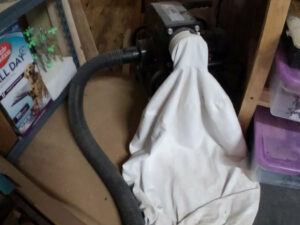 connect it to a separator and mount the whole thing on a cart to wheel around the shop.
connect it to a separator and mount the whole thing on a cart to wheel around the shop.
Last Word
When I got started with researching my Small Woodshop Dust Collection, I thought that a Shopvac was sufficient to do the job. After some research, I now know that I was sadly mistaken. I’d love to have a shop that is so clean you can eat off the floor but the nature of the material and the processes involved make that a pipe dream. I’ll keep plugging away adding additional dust collection as I build out the shop. For now, I have a good start and the shop stays relatively clean. If I had a larger budget, I would implement a central collection system and run a conduit where I need. I think I have a pretty good solution for my current needs.
I’d love to hear about your Dust Collection adventures feel free to comment and ask questions in the comments below if you need help.

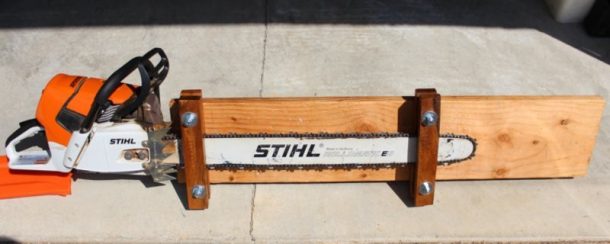
Thank you for the detailed introduction of the small woodshop dust collection system. I realize how dusty a woodshop can get, but I’ve learned a lot from your post. It’s amazing that the box fan for $20 with a couple of filters is more effective than a $125 traditional air purification system. That’s an awesome tip to save and yet get more dust out quicker. A portable dust collection seems like space and money saver too.
Wow, you are amazing at keeping your woodshop that clean! I have more dust in my house than you in your shop. 🙂
~ Julia
It is important to keep a clean shop. Dust is hazardous. There are many days when I have clogged sinuses from too much exposure. I try to keep on top of the dust so that I can continue to work in the shop.
Your site is very informative and, no doubt, helpful for those who have woodworking shops. Your DIY suggestions are very helpful because almost everybody is looking for ways to keep costs down.
Obviously, keeping our lungs healthy is a vital necessity, and it’s good to know that there are sites like yours to help us with that.
I gave up on woodworking quite a while ago, although I thought in my retirement that is what I would like to do. I had several saws, and still do have three, I think. Thanks for your comprehensive treatment of what is difficult, but no doubt, fulfilling project.
I don’t know your situation but, I would have a go at woodworking in your retirement. In my opinion, there is nothing quite as fulfilling as seeing something completed that you have made with your own two hands and a little focused effort.
What a great website you’ve created, the information is clear, concise and well written. I didn’t realise there were so many methods for clearing wood dust to be honest, I was thinking a portable system would do the job, but I guess not. Do you recommend the use of wearing a mask when working to additionally help with keeping your lungs clear? Where should the dust collection be disposed off, to be the most eco-friendly?
Yes, a mask is quite necessary. I use theFightech masks. I have used the paper masks in the past but they are not adequate for most of the fine dust that many of the machines generate especially the sanders.
As for what to do with the dust, most of what I generate either goes into a compost pile or is spread over a patch of woods adjacent to the shop. If I am cutting Black Walnut or Cedar, that dust goes into the trash or is fed into the woodstove a bit at a time. These woods generate dust that is toxic to plants so composting is not a good option.